Blackpool St Annes and Lytham Tramways
History
The Blackpool, St Annes and Lytham Tramways Company was one of three British tramway concerns to use gas propulsion (coal gas in fact), something all three came to regret. The tramway was standard gauge, and opened for business on the 11th July 1896. The initial service ran between Station Rd — on Blackpool Corporation's Lytham Road route — to Squires Gate (operated under a 21-year lease), then over company tracks to St Annes-on-the-Sea, and from there to Lytham (opened on the 21st February 1898).
Although the tramway company owned the trams, they were operated under a long-term contract by the Gas Traction Company Limited, the former providing conductors and the latter drivers. Within a matter of days, however, the operating lease was transferred to a new company — the British Gas Traction Company Limited — which had been set up on the 13th July 1896 to exploit the new opportunities that were expected to arise following the opening of the country's first gas-operated tramway. Unfortunately, the technology proved to be rather less successful than had been envisaged, and after two years of struggle (primarily with reliability and under-powering, but also with a lack of customers), the BGTCo found itself in severe financial straits, a situation that would end in its liquidation (starting on the 1st November 1899).
Although the BStALTCo had acquired larger and more powerful gas trams in 1897 and 1898, which at least allowed it to run a passable service between the two termini, the original trams not having the range to do so, the company must have looked on enviously at developments to the north of Blackpool, when in summer 1898, the Blackpool and Fleetwood Tram Road Company opened its new overhead electric tramway to general acclaim. This would have made it fairly clear to the directors of the BStALTCo that the future lay with electric traction not gas, and no doubt sensing which way the wind was blowing with the BGTCo, they floated the concern as a public company later that year (in October 1898). The new company — the Blackpool, St Annes and Lytham Tramways Company Limited — differing in name from the old company solely by the addition of 'Limited', intended to convert the tramway to electric traction as soon as possible, despite the fact that its contract with the BGTCo ran until 1905.
The new company quickly set about restoring the fortunes of the system, remedying problems with the track and attempting to meet the demand for its services, which was considerable. The company no doubt breathed a sigh of relief when the BTGCo collapsed in 1899, the tramway company taking over operation itself. At the end of the year, it sought powers to both extend the tramway and to convert it to electric traction, which were granted in July 1900. Meanwhile, the company attempted to supplement its inadequate gas tram services with horse traction, using twenty second-hand vehicles, which gave it the dubious distinction of being the last tramway system in the British Isles to introduce horse traction (on 13th April 1900). Rather predictably, this proved to be an expensive way to make up for the gas trams' deficiencies, most of the horses being sold at the end of the summer season, with a handful lingering on until May 1901.
Unfortunately, the tramway had by this time attracted the attention of a fraudulent opportunist by the name of Henry John Lawson, who was to follow a well-tried recipe for making a fortune at the expense of unsuspecting shareholders. This was done by the simple expedient of setting up a company to acquire the tramway, which would then reconstruct it, selling it on at a huge profit to a third company specifically floated to operate the tramway. Although ostensibly above board, it involved a good deal of financial chicanery (illegal in this case), which resulted in the ordinary investors in the new company being fleeced, and the company itself being saddled with a huge debt that it had no prospect of servicing. In the case of the BStALT, large sums had been raised via debentures, which the company was subsequently unable to pay the interest on, control of the tramway passing into the hands of the receivers in late 1905, and thereafter being operated chiefly for the benefit of the debenture holders. Although Lawson eventually ended up in jail, the damage had been done, and he departed the scene leaving the tramway in the ownership of two companies — the BStALTCo, and the newly created Blackpool Electric Tramways (South) Limited — a rather bizarre situation that was not resolved until 1908.
Returning to 1902, conversion of the tramway to overhead electric traction began in December 1902, the last revenue-earning gas trams running on the 27th January 1903. Although they continued to be used in support of the reconstruction, their numbers were dramatically reduced on the night of the 27th February 1903 by a gale which demolished half the depot. The first electric services commenced running three months later on the 30th May 1903 between Blackpool and Ansdell, with cars running right through to Lytham Square by the following weekend, the 6th June 1903, all bar a short length in Lytham being double track. A short extension to Lytham Cottage Hospital — built as a single track with passing loops — was opened on the 17th September 1903, a stretch of line that made little sense, especially given the company's financial situation.
The most obvious way for the company to gain passengers and improve profitability was to run its trams through to the centre of Blackpool rather than South Shore, which was on the periphery of the tourist area. Although the corporation owned all the tracks in Lytham Road (the northern section operated by the BCT and the southern section by the company), it had so far refused all requests for through running. The company, however, desperate to tap into custom in the centre of town, was able to force the corporation's hand by threatening to seek running powers of its own. Agreement was eventually reached, and from the 9th July 1905, company cars could be seen as far north as Manchester Square (on the Promenade) and Central Station (at the end of Blackpool Corporation's Central Drive tramway). This, however, proved to be a double-edged sword as the corporation kept all receipts for trips made within Blackpool (paying the company operating costs), and these turned out to be a significant proportion of the whole.
The tramway ordered ten new open-sided trams to work the new services into Blackpool — no doubt with the tourist trade very much in mind — and converted ten of its existing trams similarly. Thereafter, the tramway was operated successfully, making reasonably good profits, but such was the debt, that it was still not sufficient to cover the debenture holders' interest, let alone pay the ordinary shareholders.
Apart from a poor season in 1912 (due to the weather), passenger numbers increased significantly, and counter-intuitively, continued to rise during the Great War as not only were families keen to escape from the rigours of daily life, but large numbers of active and convalescing soldiers were also billeted to the south of Blackpool. All this combined to produce a dramatic rise in numbers riding, though the loss of men (and their skills) to the armed forces, as well as war-time restrictions on the purchase of essential items such as rails, led to a back-log of maintenance. Towards the end of the war, the company was also saved the cost of the annual rental on the Lytham Road line, the lease having expired on the 26th July 1917, though this did not impact services, which continued running over the line under the pre-existing through-running agreement.
By the end of the war, the company's financial position, whilst not exactly healthy, had improved to the point where it was able to pay the full 5% interest to which the debenture holders were entitled. Whether the situation would have continued to improve is a moot point, as the tramway's days as an independent concern were numbered, both St-Annes-on-the-Sea and Lytham Urban District Councils having the right — in 1921 — to buy the portion of the tramway within their respective municipal boundaries.
It looked for all the world as if the tramway would ultimately fall into the hands of Blackpool Corporation, the two UDCs responding positively to an approach from the former to subsume the latter. At the last minute, however, St-Annes-on-the-Sea UDC performed a volte face, rejecting Blackpool's advances and instead, approached the tramway company to see how much it would be prepared to sell for. This rather ill-thought through action, which they seemingly hadn't bothered to consult Lytham on, ended with the council agreeing to pay an eye-wateringly high price, no doubt much to the delight of the company shareholders, who probably couldn't believe their luck. Lytham UDC on the other hand, who were much more circumspect, agreed to postpone their right to purchase in exchange for a proportion of the anticipated profits. Like the company before them, the council thus embarked on its 'tramway' journey saddled with a huge debt, one which its tramway income could not hope to service. The tramway passed into the hands of St-Annes-on-the-Sea UDC on the 1st November 1920.
At its maximum, the BStALTCo tramway system totalled 7.51 route miles, 6.26 miles owned by the company and 1.25 miles leased from Blackpool Corporation (until the 26th July 1917). Services initially ran from South Shore Station in Blackpool southwards along Lytham Road, before crossing the Blackpool/St Annes boundary at Squires Gate, then continuing southwards along Clifton Drive, parallel to the coast, through St Annes-on-the-Sea and Ansdell to the southern terminus at East Beach in Lytham. From July 1905, following the conclusion of a through-running agreement, BStALTCo trams ran through to central Blackpool; although the corporation occasionally operated specials over company tracks south of Squires Gate, it did not operate regular services over them.
Uniforms
Before the demise of the BGTCo in 1899, staff working the gas tram services were in the employ of two companies, drivers being provided by the BGTCo and conductors by the tramway company. Drivers appear to have worn informal attire, whilst conductors, if records are to be believed, were issued with kepi-style caps; it is unclear whether the caps bore badges of any kind as all surviving photographs show gas tram conductors wearing flat caps. Conductors (at least) were also required to wear round licences while crewing tramcars; these bore the system title around the outside, with a number in the middle, and were usually hung from the bearer's cash-bag strap.
For the inauguration of the new electric services, staff were issued with single-breasted jackets with five nickel buttons (comprising the arms of the three towns in the title — see link), a slit-breast pocket (with button fastening) and stand-up collars; the bearer's left-hand collar bore nickel system initials, 'B & L T', probably in individual letters, whilst the right-hand collar was left plain. This style of jacket was relatively quickly superseded by a style with two breast pockets (with flaps closed by buttons) and epaulettes. The epaulettes bore the same badge as worn on the caps, along with an employee number, whilst the collars now bore system initials on both sides, seemingly of one-piece construction as opposed to individual letters.
The tensioned-crown peaked caps carried script-lettering grade badges — either 'Motorman' or 'Conductor' — above which a nickel cap badge was worn, comprising the arms of the three towns, with wreath adornment and a ribbon containing the full system title.
Tramcar crews were also issued with long, double-breasted greatcoats with five pairs of buttons, three waist/hip-level pockets, epaulettes and high fold-over collars; other than the buttons, the greatcoats did not bear insignia. Motormen and conductors were also required to wear a round licence badge while crewing tramcars; these were presumably the same as those issued to gas tram conductors.
During the gas-tram era, inspectors wore single-breasted jackets with hidden buttons (or more likely a hook and eye affair), all edged in a finer material than the main body, inclusive of elaborately embellished cuffs; the jackets bore stand-up collars with the grade — 'Inspector' — in embroidered script lettering (at least on the bearer's right-hand side). Headgear took the form of a kepi-style cap, which does not appear to have borne a badge of any kind, though the one surviving photograph is hardly conclusive. In the electric era, inspectors wore very similar uniforms, but with two slit breast pockets, again edged in a finer material. The collars now bore the grade — 'Inspector' — in embroidered script lettering on the bearer's left-hand side, and system initials on the right-hand side, though markedly longer than on the regular uniform collars — possibly BStA& LT. Caps were by this time of the tensioned-crown type, which initially just bore the company cap badge, though possibly in brass/gilt rather than nickel. By 1912 at the latest, a hat band had been added; this bore the grade in embroidered script lettering.
The tramway company also had at least one timekeeper. The uniform jacket and insignia were identical to those worn by tramcar crews; the cap, however, bore the grade — 'Timekeeper' — on a hat band in embroidered script lettering.
The company also employed young lads as points boys, and for a very short time (between November 1914 and March 1916) parcels boys. The former wore identical uniforms to motormen and conductors, but with a script-lettering 'Pointsboy' cap badge. Parcels boys probably had a nickel 'Parcels' badge on their caps, as well as on their collars, or at least the left-hand one (from the one surviving photograph).
Like many tramways across the British Isles, the BStALT employed women during the Great War to replace men lost to the armed services. The first ladies were set on as conductresses on the 13th June 1915, and by April of the following year, all but one of the conducting staff were female; if the surviving newspaper articles are to be trusted, these ladies were issued with smart blue uniforms edged/piped in red and white. The uniforms comprised tailored, single-breasted jackets with five buttons, lapels and epaulettes, along with a waist belt (with button fastening) and long matching skirt. The jackets also bore prominent cuffs embellished with three buttons. Caps were reported to be tight-fitting and without a peak, though the one surviving photo shows conductresses wearing dark-coloured straw bonnets, which were presumably for summer wear. The hats purportedly bore an enamelled cap badge, an example of which has unfortunately not yet come to light. The last conductress left in September 1919.
The one surviving photograph of Great War conductresses shows the majority of them with licence badges hung from an epaulette button, a method much favoured by Blackpool Corporation Tramways staff.
Further reading
For a detailed history of the system, see: 'Lytham Trams — The Blackpool, St Annes & Lytham Tramway' by Brian Turner; self published (2020).
Images
Gas tram drivers and conductors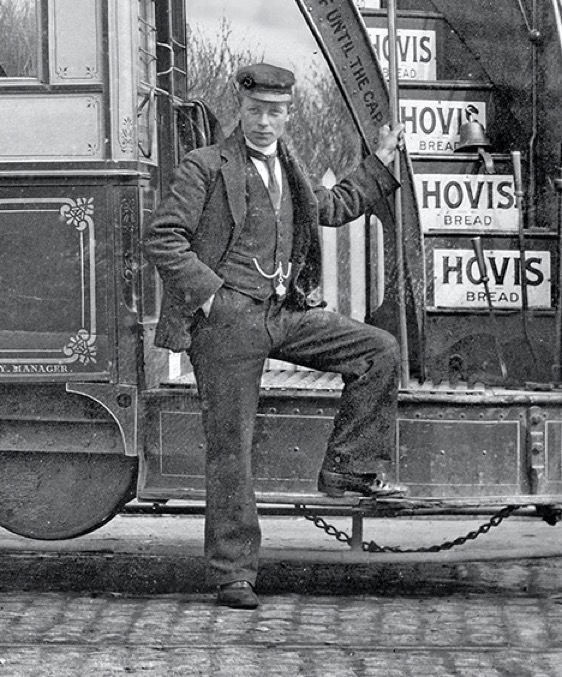
The driver of one of the company's small gas trams captured for posterity at South Shore Station — photo undated, but probably taken in the late 1890s. The individual pictured would more than likely have been an employee of the British Gas Traction Company. He is wearing informal attire with no sign of a licence badge, though this may well be on the far (hidden) side of his jacket. Photo courtesy of Brian Turner.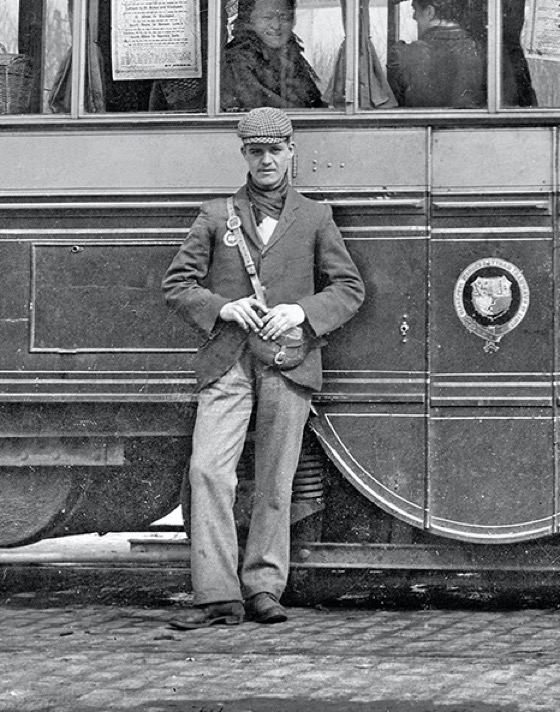
Another enlargement from the same photograph as above, this time showing the conductor. He also is wearing informal attire, and clearly has a licence suspended from his cash-bag strap, almost certainly of the type shown below. Photo courtesy of Brian Turner.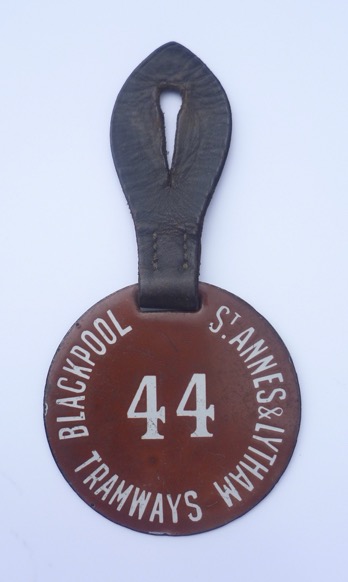
BStALT licence No 44 — white on red enamel. It seems likely that these licences were worn by both drivers and conductors from gas tramway days (late 1890s) through to the twilight years of the electric tramway operation in the mid 1930s. Author's Collection.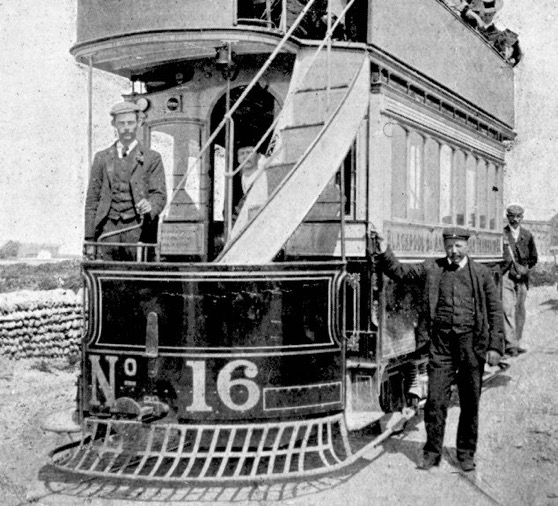
The crew of Gas Tram No 16 pose for the cameraman in 1899. Neither the conductor (at the rear) nor the driver (on the platform) are wearing a uniform. Photo courtesy of the National Tramway Museum.
Motormen and conductors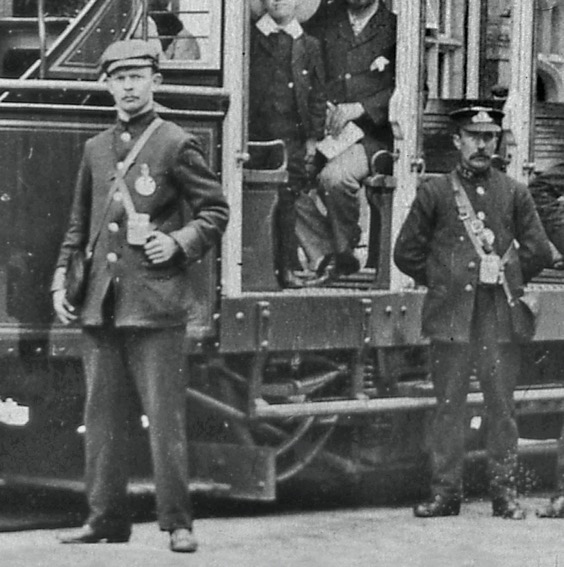
Two conductors stand before a brand-new Tramcar No 35 at Lytham Square in 1905. The man on the right is wearing a tensioned-crown peaked cap with a grade badge — 'Conductor' — and a company cap badge; his left-hand collar bears 'B & L T' system initials, whilst the right is left plain. The man on the left is wearing a flat cap, so he may well be one of the depot staff or a seasonal employee. Both men have licence badges (see above for an example). Photo courtesy of the Brian Turner Collection.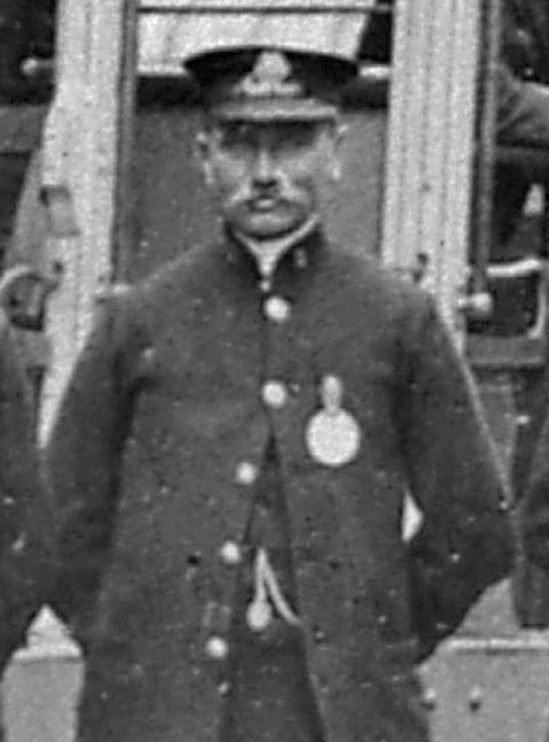
Another blow-up of the Lytham Square photograph, this time showing a motorman. He is wearing a company cap badge with a script-lettering grade badge — 'Motorman' — below. His jacket bears a single slit breast pocket, from which his licence badge is hung, possibly from a button located there expressly for this purpose. Photo courtesy of the Brian Turner Collection.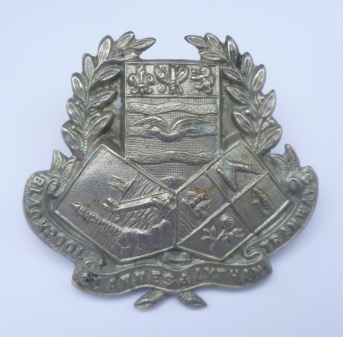
Blackpool, St Annes and Lytham Tramways Company cap badge — nickel. From the late-Edwardian era, this was also worn on the jacket epaulettes. Author's Collection.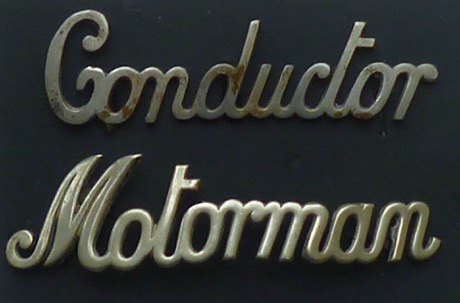
Standard off-the-shelf script-lettering cap badges of the type worn by Blackpool, St Annes and Lytham Tramways Company staff — nickel. Author's Collection.
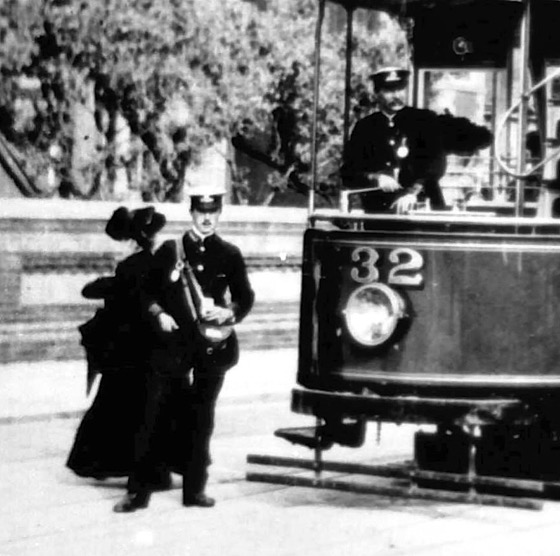
The crew of what appears to be a brand-new Tramcar No 32 pose for the cameraman in St Annes, dating the image to 1905 or 1906. Both men are wearing white summer-issue rain covers on their caps. Photo courtesy of Duncan Holden.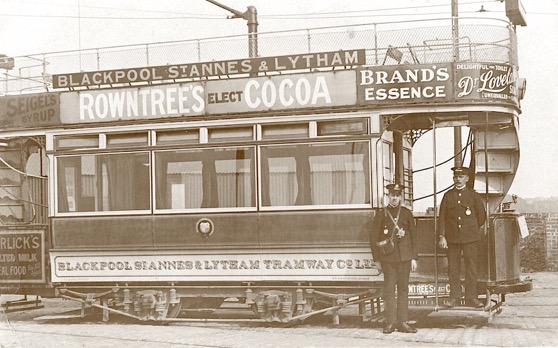
An unidentified BStALTCo tramcar along with its crew at Squires Gate — photo undated, but certainly taken between 1906 (the manager on the rocker panel is Mr Laing) and 1910 when the depot was extended. My thanks to Brian Turner for the location and dating. Author's Collection.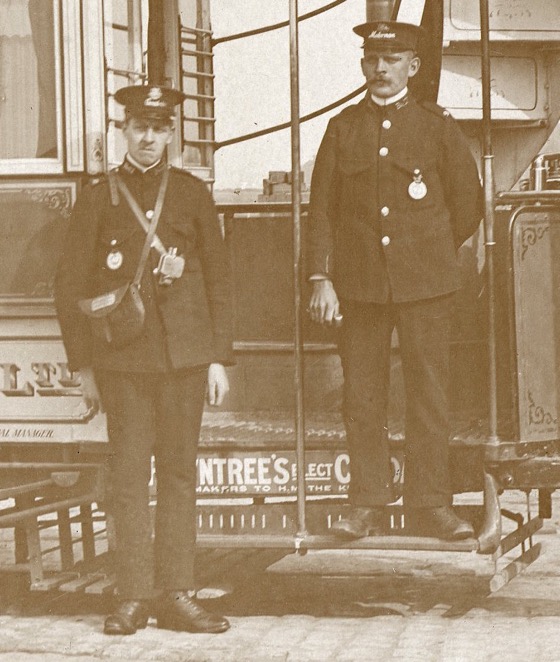
An enlargement of the above photograph showing the motorman and the conductor. Magnification reveals the collar insignia to be system initials, 'B & L T'. By this time, the uniform jackets had two breast pockets (with button-closed flaps), as well as epaulettes.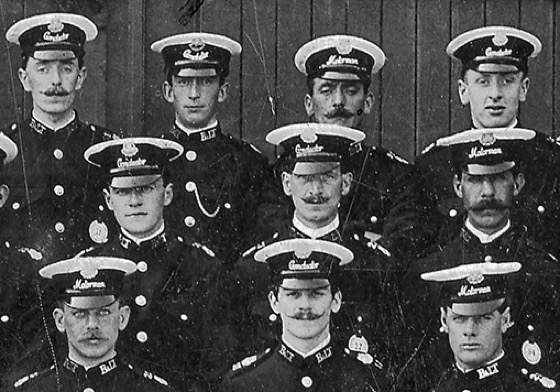
A section of a larger 1912 staff photograph showing a group of motormen and conductors. The B & LT collar initials are easily made out, and appear to be of one-piece construction rather than individual letters. The epaulettes appear to carry the same badge as worn on the caps, along with an employee number. Photo courtesy of the Brian Turner Collection.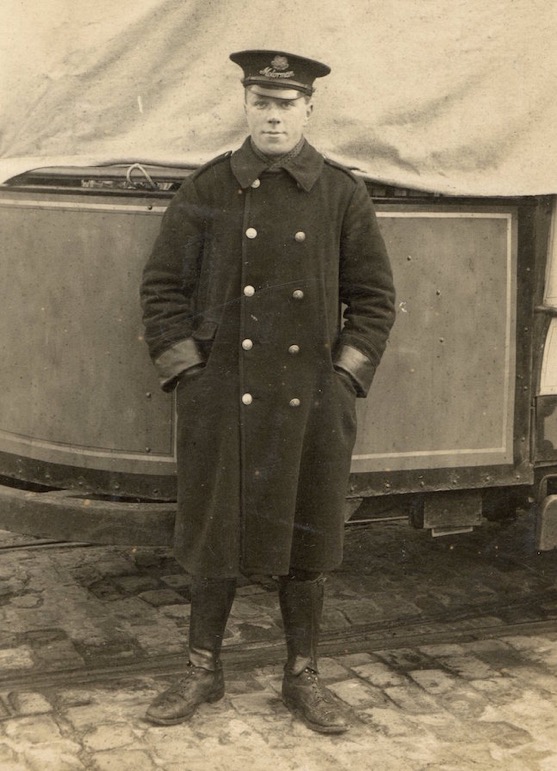
A motorman stands with his tram, which has a tarpaulin to shield him from windblown sand — the message on the back of the original photo is dated 17th January 1919, and is signed "From your big nephew, Tom". Note the gaiters (possibly war surplus) and the poor state of his boots. Author's Collection.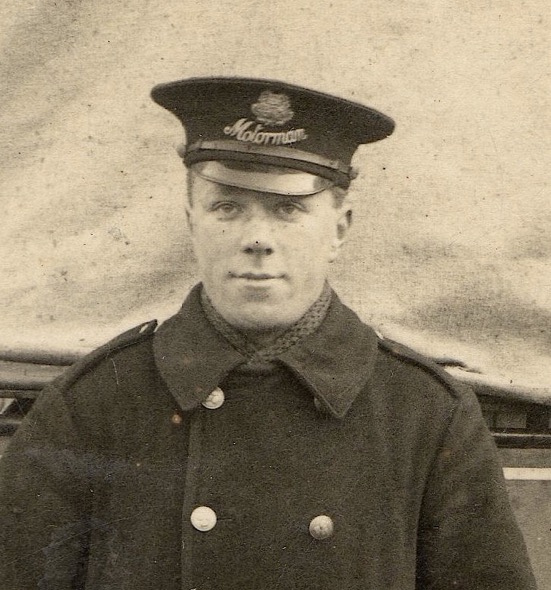
An enlargement of the above photograph showing details of the cap badge.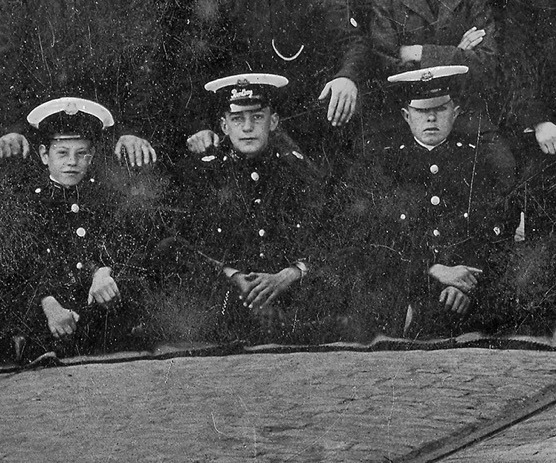
A group of young lads on a staff photograph taken in 1912. The individual in the middle is a points boy, his grade carried on his cap. It is unclear what positions the other lads hold.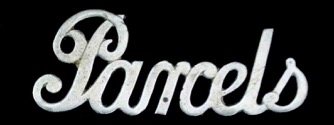
A script-lettering grade badge — nickel — of the type worn by BStALT parcels boys between 1914 and 1916. Author's Collection.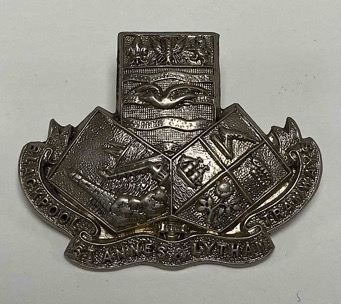
Blackpool, St Annes and Lytham Tramways Company cap badge — nickel. Note that this badge is without the wreath adornment or the ribbon ends (at the bottom) of the usual cap badge. This is the only example I am aware of, so it is uncertain whether it was ever issued or if it is a single specimen made by the badge manufacturer for consideration by the company. With thanks to the National Tramway Museum.
Senior staff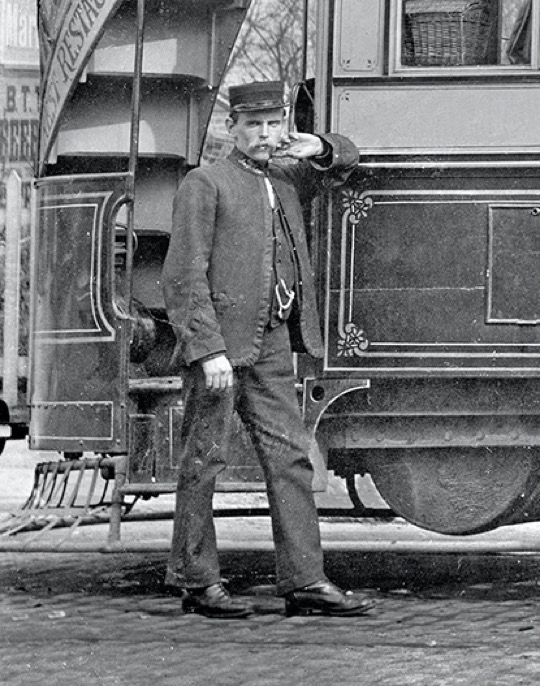
Another enlargement from the South Shore Station photograph above, but this time showing an inspector. His jacket is edged in a finer material than the main body, this material also being used to embellish the sleeve cuffs. His right-hand collar bears his grade — 'Inspector' — in embroidered script lettering. Photo courtesy of Brian Turner.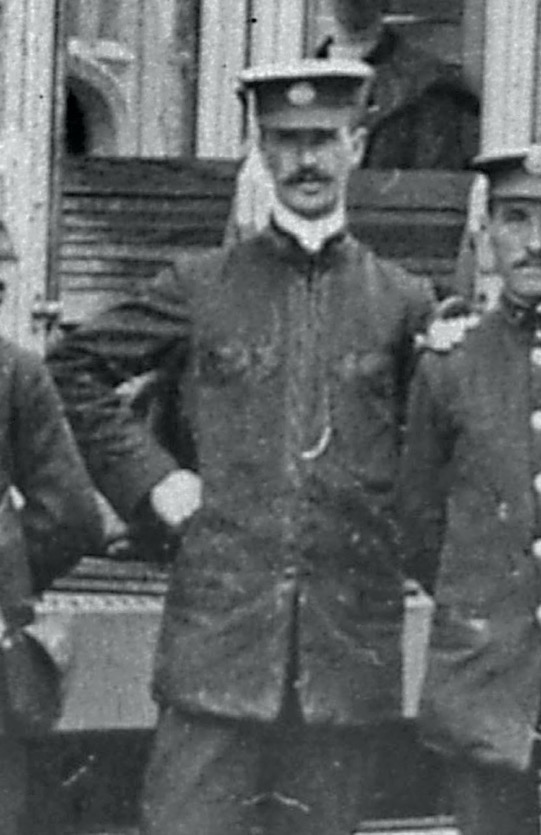
A BStALTCo inspector with Tramcar No 35 in Lytham Square in 1905. Whilst he is almost certainly wearing a company cap badge, there is no sign of a grade badge on his cap. Although difficult to tell on this photograph, his left-hand collar carries his grade — 'Inspector' — in embroidered script lettering, whilst the right-hand side bears system initials. Photo courtesy of the Brian Turner Collection.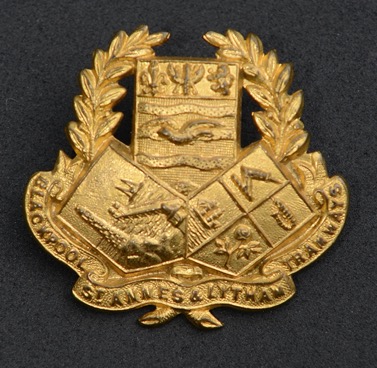
Blackpool, St Annes and Lytham Tramways Company cap badge — gilt. This material may have been used for issue to inspectors, though this is no more than supposition. With thanks to John Lodge.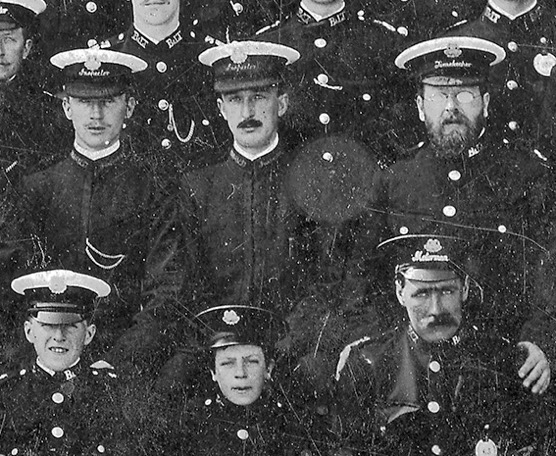
An enlargement of a large 1912 staff photograpg showing two of the six inspectors (middle row; left and middle) and a timekeeper (middle row; right). The inspectors' collar insignia and cap grade badge all appear to be embroidered. Curiously, the system initials (on the inspectors' right-hand collars) are clearly longer than the metal equivalents used on the tramcar crew collars, probably 'BLStA& LT' Photo courtesy of the Brian Turner Collection.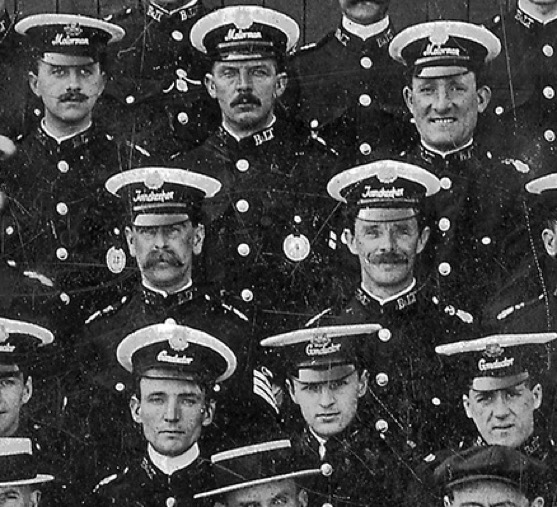
Another two timekeepers (middle row; left and right) but with what may be metal rather than embroidered grade badges on their caps.
Female staff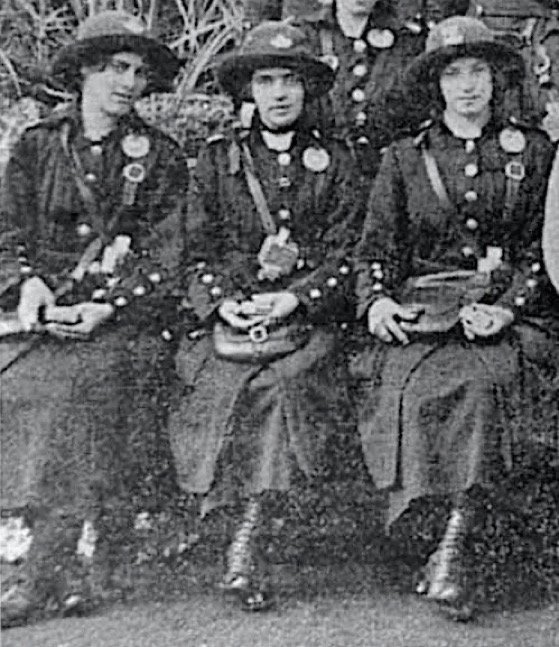
An enlargement of what is currently the only known surviving photograph of BStALTCo Great War tram conductresses. The uniforms are not only smart, but very distinctive with the prominent three-button cuffs. All the ladies in the larger photograph have their licence badges suspended from the button fastening of one of their epaulettes, a way of wearing them much in vogue on Blackpool Corporation Tramways (see link). Photo courtesy of the Brian Turner Collection.